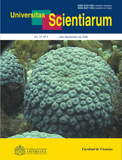Abstract
El crisantemo (Dendrathema grandiflora) presenta alta demanda en los mercados de flor cortada, tanto colombianos como internacionales. La producción de esta especie se ve seriamente afectada por enfermedades fúngicas como la roya Blanca (Puccinia horiana), lo que ocasiona que se empleen grandes cantidades de fungicidas aumentando los costos de producción a nivel económico y ecológico. La evaluación de sistemas de regeneración in vitro de crisantemo a partir de discos de hoja constituyó un primer paso hacia el empleo de la transformación genética, como apoyo a las técnicas de mejoramiento convencional para la obtención de plantas resistentes al hongo. Se establecieron discos de hoja de D. grandiflora var. Escapade, var. White albatross y var. Yellow albatross sobre medio MS en presencia ANA (0 - 4.83 mM) y BAP (0 - 13.32 mM) solos y en combinación. Así mismo, se establecieron discos foliares de las tres variedades en estudio sobre el medio MumB en presencia 2,4-D (0 - 4.52 mM) durante 7, 14 y 21 días, tiempo en el cual los explantes fueron transferidos a medio a medio Mum B sin 2-4D. Los brotes regenerados, fueron individualizados, enraizados y endurecidos. Los resultados obtenidos indican que el medio MS suplementado con: ANA 4.83 mM + BAP 4.44 mM ó ANA 4.83 mM y BAP 13.32 mM permite la regeneración de plantas vía organogénesis para las tres variedades y que es posible obtener embriones somáticos de las tres variedades, sobre medio Mum B en presencia de 2,4-D 2.26 mM, con periodos de incubación de 14 días para White Albatross y 21 días para Yellow Albatros y Escapade. El medio Mum B sin 2,4-D, permite el desarrollo de los brotes, a partir de embriones somáticos en los tres casos. El 85% de los brotes obtenidos presentaron enraizamiento espontáneo, lo que facilitó el endurecimiento y transferencia exitosa a suelo.
Palabras clave: Dendrathema grandiflora, regeneración in vitro, organogénesis, embriogénesis somática.
Abstract
Chrysanthemum (Dendrathema grandiflora) has a high demand in the Colombian and international cut flower markets. Since commercial production of this ornamental species is strongly affected by fungal diseases such as chrysanthemum white rust (Puccinia horiana), high doses of fungicides are being used posing increased environmental and commercial costs. Assessment of in vitro regeneration systems from leaf discs was a first step in developing a plant genetic transformation protocol to obtain fungi-resistant plants. Leaf discs of White Albatross, Yellow Albatross, and Escapade varieties were established in vitro on MS medium supplemented with NAA (0 - 4.83 μM) and BAP (0 - 13.32 μM) alone and in combination. Leaf discs were also cultured on MumB medium containing 2,4-D (0 - 4.52 μM) for 7, 14, and 21 days prior to their transferral to a 2,4-D free MumB medium. Regenerated shoots were individualized, rooted, and hardened. Results show that MS with 4.83 μM NAA + 4.44 μM BAP and 4.83 μM NAA + 13.32 μM BAP induce organogenesis, and MumB with 2.26 μM 2,4-D induces somatic embryogenesis on all three varieties, with exposition periods to 2,4-D of 14 days for White Albatross and 21 days for Yellow Albatross and Escapade. Shoot development from somatic embryos was observed in the three varieties when cultured on a 2,4-D free MumB medium. Spontaneous rooting was recorded in 85% of the shoots thus facilitating hardening and successful transfer to soil.
Key words: Dendrathema grandiflora, in vitro regeneration, organogenesis, somatic embryogenesis.
Univ. Sci. is registered under a Creative Commons Attribution 4.0 International Public License. Thus, this work may be reproduced, distributed, and publicly shared in digital format, as long as the names of the authors and Pontificia Universidad Javeriana are acknowledged. Others are allowed to quote, adapt, transform, auto-archive, republish, and create based on this material, for any purpose (even commercial ones), provided the authorship is duly acknowledged, a link to the original work is provided, and it is specified if changes have been made. Pontificia Universidad Javeriana does not hold the rights of published works and the authors are solely responsible for the contents of their works; they keep the moral, intellectual, privacy, and publicity rights. Approving the intervention of the work (review, copy-editing, translation, layout) and the following outreach, are granted through an use license and not through an assignment of rights. This means the journal and Pontificia Universidad Javeriana cannot be held responsible for any ethical malpractice by the authors. As a consequence of the protection granted by the use license, the journal is not required to publish recantations or modify information already published, unless the errata stems from the editorial management process. Publishing contents in this journal does not generate royalties for contributors.



